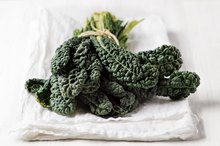Nutrition Information for Roasted Red Peppers
There a several types of red peppers on the market, and one of the more popular is the red bell pepper 1. In its raw state, the red pepper is very high in sugar and dietary fiber, vitamin A, vitamin B-6 and vitamin C. It also contains high levels of manganese, niacin, potassium, riboflavin, and thiamine. The red pepper is very low in saturated fat and sodium, and contains no cholesterol.
Tips
Roasted Red Peppers has 321 Calories and 7.14 g of Protein per 100 gram serving according to the nutrition facts provided by the USDA Food Composition Database.
Effects of Roasting
When a red pepper is roasted, its intrinsic weight decreases from the loss of moisture content, so a roasted red pepper is slightly shriveled. However, the peppers should only roast for about five minutes. After this, you should put the roasted peppers into a food-quality plastic bag, close the top and leave them to steam until the flesh is cooked. This results in very little loss of nutrients. If anything, the nutrients of a roasted pepper become more concentrated 1.
- When a red pepper is roasted, its intrinsic weight decreases from the loss of moisture content, so a roasted red pepper is slightly shriveled.
- However, the peppers should only roast for about five minutes.
Vitamin C
The Health Benefits of Cauliflower
Learn More
Just half a cup of roasted red peppers provides you with nearly all your recommended daily amount of vitamin C. Vitamin C tends to be destroyed by cooking, but quick roasting methods will only reduce the vitamin content slightly. Roasted red peppers have not been cooked in water, which would leach away the vitamin C, so they retain much of the vitamin 1. The vitamin C content of 100 g of raw red pepper is 127.7 mg. The amount of vitamin C left in 100 g of red peppers that have been boiled is just 41.2 mg. Thanks to the reduced volume of roasted red peppers, their vitamin C content is actually higher than raw, at 162.8 mg per 100 g.
- Just half a cup of roasted red peppers provides you with nearly all your recommended daily amount of vitamin C. Vitamin C tends to be destroyed by cooking, but quick roasting methods will only reduce the vitamin content slightly.
- The amount of vitamin C left in 100 g of red peppers that have been boiled is just 41.2 mg.
Provitamin A Carotenoids
The vitamin A in red peppers is found in its provitamin A carotenoids form. This produces the red color of the peppers. This vitamin A precursor includes beta-carotene, alpha-carotene, beta-cryptoxanthin, lycopene, lutein and zeaxanthin.include:
- This vitamin A precursor includes beta-carotene
- alpha-carotene
- beta-cryptoxanthin
- lycopene
- lutein
- zeaxanthin
These precursors need to be converted into the kind of vitamin A that your body can use, which is an inefficient biochemical process.
Vitamin A
How Many Calories in Red Stripe Beer?
Learn More
Vitamin A in the raw red peppers is identified as RAE, or retinol activity equivalents 1. Roasting or cooking alters this compound. Once red peppers are cooked, the vitamin A content can be measured in terms of its individual precursors.
Other Nutrients
Red peppers are very low in calories to begin with, but the effects of cooking increase their calories slightly.
Related Articles
References
- Daily Herald: Both raw and roasted sweet red bell peppers are rich in nutrients
- Sweetware: Vitamin A Technical Details
- Peppers, sweet, red, raw. FoodData Central. U.S. Department of Agriculture. Published April 1, 2019.
- Pepper, sweet, green, raw. U.S. Department of Agriculture. Published April 1, 2020.
- National Institutes of Health Office of Dietary Supplements. Vitamin C fact sheet for health professionals. Updated July 9, 2019.
- National Institutes of Health Office of Dietary Supplements. Manganese fact sheet for health professionals. Updated September 6, 2019.
- Fiedor J, Burda K. Potential role of carotenoids as antioxidants in human health and disease. Nutrients. 2014;6(2):466-88. doi:10.3390/nu6020466
- Mozos I, Stoian D, Caraba A, Malainer C, Horbańczuk JO, Atanasov AG. Lycopene and Vascular Health. Front Pharmacol. 2018;9:521. doi:10.3389/fphar.2018.00521
- Shotorbani N, Jamei R, Heidari R. Antioxidant activities of two sweet pepper Capsicum annuum L. varieties phenolic extracts and the effects of thermal treatment. Avicenna J Phytomed. 2013;3(1):25-34.
- Centers for Disease Control and Prevention. Learn about age-related macular degeneration. Updated July 18, 2018.
- Eisenhauer B, Natoli S, Liew G, Flood VM. Lutein and zeaxanthin--food sources, bioavailability and dietary variety in age-related macular degeneration protection. Nutrients. 2017;9(2). doi:10.3390/nu9020120
- Boyd K. Vitamins for AMD. American Academy of Ophthalmology. Updated May 21, 2018.
- Maioli C, Tagliabue L, Cioni F. Osteoporosis and mineral nutrition. A literature review. Progr Nutr. 2018;20(3):305-12. doi:10.23751/pn.v20i3.6861
- Nucera E, Rizzi A, Buonomo A, et al. The clinical meaning of positive latex sIgE in patients with food/pollen adverse reactions. Int J Immunopathol Pharmacol. 2012;25(2):445-53. doi:10.1177/039463201202500214
- Aghajanpour M, Nazer MR, Obeidavi Z, Akbari M, Ezati P, Kor NM. Functional foods and their role in cancer prevention and health promotion: a comprehensive review. Am J Cancer Res. 2017;7(4):740-769.
Writer Bio
Anne Evans has been writing professionally since 2008. Previously, she worked in the emergency department of a health care trust. Her specialty areas of knowledge are medical, legal, technical and scientific terminology. Evans studied to postgraduate level in applied linguistics at Cardiff University.









